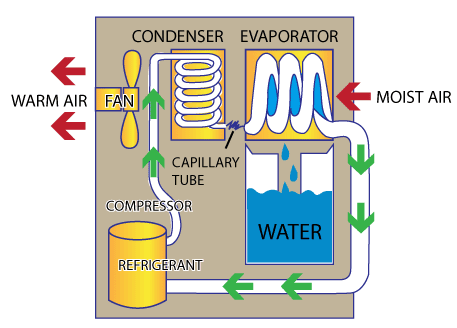Maybe you’re always wondering how things work, or maybe you just can’t take that sticky humid feeling any longer. Either way, it can’t hurt to ask, how does a dehumidifier work? What are the mechanisms that allow dehumidifiers with pumps to take moisture, in vapor form, from the air and turn it into it liquid water?
To explain, Dehumidifiers simply regulate the humidity in a room by removing excess moisture from the air. As a result, they create living conditions that are inhospitable to dust mites, mold, and other allergen-causing organisms. There are two primary methods that allow dehumidifiers to remove moisture from the air. However, for this article, we are going to focus on refrigerant-based dehumidifiers, which are typically the most popular style of dehumidifiers. So how does dehumidifiers for basements or dehumidifiers with pumps work? Read on to find out how!
The mechanics behind a refrigerant-style dehumidifier are actually quite simple. Have you ever noticed how moisture forms on the outside of a cold glass of water on a hot day? That’s condensation, and once you know that, understanding how a dehumidifier works becomes a lot easier.
Dehumidifiers, like Danby, Frigidaire, AprilAire, and Fral work much like air conditioners. Specifically, warm, moist air is drawn into the dehumidifier by a fan and then crosses over the refrigerant-cooled coils. This process causes the moisture passing through the dehumidifier to condense on the coils within the machine. But why?
 Like a glass of ice water, dehumidifier refrigerant coils are colder than the air that is passing through them. As this air cools, its ability to hold and retain moisture diminishes. Once the air has more moisture than it can hold, it forms condensation. Next, the cooled air passes back over the dehumidifier’s warm motor, which slightly reheats the air before it discharges back into the room. The now dry and slightly warm air exits the dehumidifier and attracts the surrounding more moisturized air like a magnet, continually maximizing the dehumidifier’s efficiency.
Like a glass of ice water, dehumidifier refrigerant coils are colder than the air that is passing through them. As this air cools, its ability to hold and retain moisture diminishes. Once the air has more moisture than it can hold, it forms condensation. Next, the cooled air passes back over the dehumidifier’s warm motor, which slightly reheats the air before it discharges back into the room. The now dry and slightly warm air exits the dehumidifier and attracts the surrounding more moisturized air like a magnet, continually maximizing the dehumidifier’s efficiency.
Most dehumidifiers typically have a drip pan or a removable bucket where the condensed water collects for easy disposal. These removable buckets or trays are most often present in smaller Single Room Dehumidifiers. In contrast, larger space, or Whole House Dehumidifiers like Basement, Crawlspace, and Restoration dehumidifiers are usually equipped with a built-in pump for worry-free, continuous drainage.
The Fral FDK54 Dehumidifier is a commercial-grade large-space or whole-home dehumidifier. It’s perfect for homeowners or businesses who want a continually powerful and effective solution for moisture control in large areas. Despite its powerful nature, its compact size makes it perfect for basements, garages, cellars, crawlspaces, warehouses, and workshops up to 2,500 square feet in size. Fral’s FDK54 is a fixed dehumidifier that can be used as both a ducted or standalone unit. It boasts continuous drainage, a digital humidistat and display, low-temperature operation down to 33°F, and an automatic hot gas defrosting system. Check out our selection of dehumidifiers for sale like our Industrial, Whole House, and Single Room dehumidifiers today!
Here is a breakdown of the steps that a dehumidifier takes during operation:
- Air is drawn into the unit by a fan
- Air passes over the cooled coils
- As the air is cooled, its moisture condenses
- Water falls into the drip pan or removable bucket
- Air is then reheated by the heat recovery system
- Air that is 2° Celsius warmer and considerably dryer disperses back into the room
- The defrost system will automatically de-ice the unit as necessary
- The dehumidifier will automatically shut off when the drainage bucket is full—you don’t have to worry about it
- When the dehumidifier achieves the selected level of dryness in the room, it will automatically turn off
That’s all there is to it!
How does a dehumidifier work? Now that you know, you’re ready to shop all home dehumidifiers. If you’re interested in learning more about home and commercial dehumidifiers for water damage, humidity, or controlling excess moisture, visit any of these Learning Center resources.
✔ Dehumidifier Buying Guide
✔ Top Five Crawlspace Dehumidifiers
✔ Top Five Basement Dehumidifiers
✔ Top Five Room Dehumidifiers
✔ Mold FAQs
✔ Common Types of Household Mold
